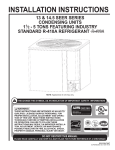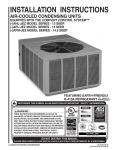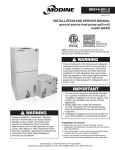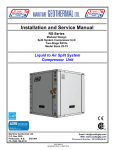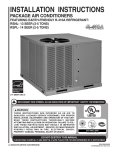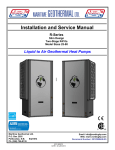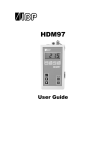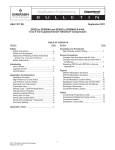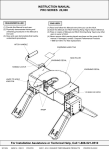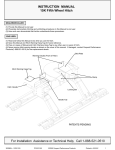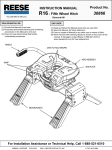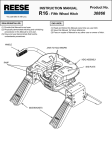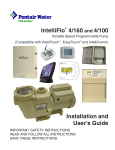Download Rheem 16AJL Specifications
Transcript
INSTALLATION INSTRUCTIONS 16 SEER SERIES CONDENSING UNITS 2 - 5 TONS FEATURING INDUSTRY STANDARD R-410A REFRIGERANT EQUIPPED WITH CORE SENSE CONTROL NOTE: Appearance of unit may vary. ! RECOGNIZE THIS SYMBOL AS AN INDICATION OF IMPORTANT SAFETY INFORMATION! ! WARNING THESE INSTRUCTIONS ARE INTENDED AS AN AID TO QUALIFIED, LICENSED SERVICE PERSONNEL FOR PROPER INSTALLATION, ADJUSTMENT AND OPERATION OF THIS UNIT. READ THESE INSTRUCTIONS THOROUGHLY BEFORE ATTEMPTING INSTALLATION OR OPERATION. FAILURE TO FOLLOW THESE INSTRUCTIONS MAY RESULT IN IMPROPER INSTALLATION, ADJUSTMENT, SERVICE OR MAINTENANCE POSSIBLY RESULTING IN FIRE, ELECTRICAL SHOCK, PROPERTY DAMAGE, PERSONAL INJURY OR DEATH. ISO 9001:2008 DO NOT DESTROY THIS MANUAL PLEASE READ CAREFULLY AND KEEP IN A SAFE PLACE FOR FUTURE REFERENCE BY A SERVICEMAN 92-21354-88-01 SUPERSEDES 92-21354-88-00 TABLE OF CONTENTS 1.0 SAFETY INFORMATION . . . . . . . . . . . . . . . . . . . . . . . . . . . . . . . . . . . . . . . . . . . . 3 2.0 GENERAL . . . . . . . . . . . . . . . . . . . . . . . . . . . . . . . . . . . . . . . . . . . . . . . . . . . . . . . 5 2.1 Checking Product Received. . . . . . . . . . . . . . . . . . . . . . . . . . . . . . . . . . . . . . 5 2.2 Application . . . . . . . . . . . . . . . . . . . . . . . . . . . . . . . . . . . . . . . . . . . . . . . . . . . 5 2.3 Dimensions . . . . . . . . . . . . . . . . . . . . . . . . . . . . . . . . . . . . . . . . . . . . . . . . . . 6 2.4 Electrical and Physical Data . . . . . . . . . . . . . . . . . . . . . . . . . . . . . . . . . . . . . 6 3.0 LOCATING UNIT . . . . . . . . . . . . . . . . . . . . . . . . . . . . . . . . . . . . . . . . . . . . . . . . . . 7 3.1 Corrosive Environment . . . . . . . . . . . . . . . . . . . . . . . . . . . . . . . . . . . . . . . . . 7 3.2 Condenser Location. . . . . . . . . . . . . . . . . . . . . . . . . . . . . . . . . . . . . . . . . . . . 7 3.3 Operational Issues . . . . . . . . . . . . . . . . . . . . . . . . . . . . . . . . . . . . . . . . . . . . . 8 3.4 For Condensers With Space Limitations . . . . . . . . . . . . . . . . . . . . . . . . . . . . 8 3.5 Customer Satisfaction Issues . . . . . . . . . . . . . . . . . . . . . . . . . . . . . . . . . . . . 8 3.6 Proper Installation . . . . . . . . . . . . . . . . . . . . . . . . . . . . . . . . . . . . . . . . . . . . . 8 3.7 Unit Mounting. . . . . . . . . . . . . . . . . . . . . . . . . . . . . . . . . . . . . . . . . . . . . . . . . 8 3.8 Factory-Preferred Tie-Down Method for Outdoor Units . . . . . . . . . . . . . . . . . 8 4.0 REFRIGERANT CONNECTIONS . . . . . . . . . . . . . . . . . . . . . . . . . . . . . . . . . . . . . 9 5.0 TOOLS REQUIRED FOR INSTALLING & SERVICING R-410A MODELS . . . . . 9 5.1 Specifications of R-410A . . . . . . . . . . . . . . . . . . . . . . . . . . . . . . . . . . . . . . . . 9 5.2 Quick Reference Guide for R-410A . . . . . . . . . . . . . . . . . . . . . . . . . . . . . . . . 9 6.0 REPLACEMENT UNITS. . . . . . . . . . . . . . . . . . . . . . . . . . . . . . . . . . . . . . . . . . . . 10 7.0 EVAPORATOR COIL . . . . . . . . . . . . . . . . . . . . . . . . . . . . . . . . . . . . . . . . . . . . . . 10 8.0 REPLACEMENT UNITS. . . . . . . . . . . . . . . . . . . . . . . . . . . . . . . . . . . . . . . . . . . . 10 9.0 INTERCONNECTING TUBING . . . . . . . . . . . . . . . . . . . . . . . . . . . . . . . . . . . . . . 10 9.1 Vapor and Liquid Lines . . . . . . . . . . . . . . . . . . . . . . . . . . . . . . . . . . . . . . . . 10 9.2 Maximum Length of Lines . . . . . . . . . . . . . . . . . . . . . . . . . . . . . . . . . . . . . . 11 9.3 Outdoor Unit Installed Above or Below Indoor Coil . . . . . . . . . . . . . . . . . . . 11 9.4 Tubing Installation . . . . . . . . . . . . . . . . . . . . . . . . . . . . . . . . . . . . . . . . . . . . 13 9.5 Tubing Connections . . . . . . . . . . . . . . . . . . . . . . . . . . . . . . . . . . . . . . . . . . . 13 9.6 Leak Testing . . . . . . . . . . . . . . . . . . . . . . . . . . . . . . . . . . . . . . . . . . . . . . . . 13 10.0 EVACUATION PROCEDURE . . . . . . . . . . . . . . . . . . . . . . . . . . . . . . . . . . . . . . . 14 11.0 START UP AND PERFORMANCE . . . . . . . . . . . . . . . . . . . . . . . . . . . . . . . . . . . 14 12.0 CHECKING AIRFLOW . . . . . . . . . . . . . . . . . . . . . . . . . . . . . . . . . . . . . . . . . . . . . 14 13.0 CHECKING REFRIGERANT CHARGE . . . . . . . . . . . . . . . . . . . . . . . . . . . . . . . . 15 13.1 Charging Using Charging Chart. . . . . . . . . . . . . . . . . . . . . . . . . . . . . . . . . . 15 13.2 Charging By Weight . . . . . . . . . . . . . . . . . . . . . . . . . . . . . . . . . . . . . . . . . . . 16 13.3 Final Leak Testing . . . . . . . . . . . . . . . . . . . . . . . . . . . . . . . . . . . . . . . . . . . . 16 14.0 ELECTRICAL WIRING. . . . . . . . . . . . . . . . . . . . . . . . . . . . . . . . . . . . . . . . . . . . . 16 14.1 Grounding . . . . . . . . . . . . . . . . . . . . . . . . . . . . . . . . . . . . . . . . . . . . . . . . . . 16 14.2 Power Wiring . . . . . . . . . . . . . . . . . . . . . . . . . . . . . . . . . . . . . . . . . . . . . . . . 16 14.3 Control Wiring . . . . . . . . . . . . . . . . . . . . . . . . . . . . . . . . . . . . . . . . . . . . . . . 17 15.0 FACTORY INSTALLED ACCESSORIES . . . . . . . . . . . . . . . . . . . . . . . . . . . . . . 17 15.1 Core Sense . . . . . . . . . . . . . . . . . . . . . . . . . . . . . . . . . . . . . . . . . . . . . . . . . 17 15.2 Interpreting The Diagnostic LEDS . . . . . . . . . . . . . . . . . . . . . . . . . . . . . . . . 17 15.3 Control Box Cover . . . . . . . . . . . . . . . . . . . . . . . . . . . . . . . . . . . . . . . . . . . . 17 16.0 THERMOSTAT USAGE WITH THE 16 SEER CONDENSING UNIT . . . . . . . . . 18 17.0 CORE SENSE . . . . . . . . . . . . . . . . . . . . . . . . . . . . . . . . . . . . . . . . . . . . . . . . . . . 18 18.0 CORE SENSE WITH ACTIVE PROTECTION WHEN USED WITH WHITE-RODGERS THERMOSTAT. . . . . . . . . . . . . . . . . . . . . . . . . . . . . . 18 19.0 RESETTING THE WHITE-RODGERS THERMOSTAT AFTER A HARD LOCKOUT . . . . . . . . . . . . . . . . . . . . . . . . . . . . . . . . . . . . . . . . . . . . . . 19 20.0 FIELD INSTALLED ACCESSORIES . . . . . . . . . . . . . . . . . . . . . . . . . . . . . . . . . . 19 20.1 Compressor Crankcase Heater (CCH) . . . . . . . . . . . . . . . . . . . . . . . . . . . . 19 20.2 Time Delay Control (TDC) . . . . . . . . . . . . . . . . . . . . . . . . . . . . . . . . . . . . . . 19 20.3 Low Ambient Control (LAC) . . . . . . . . . . . . . . . . . . . . . . . . . . . . . . . . . . . . . 22 20.4 High and Low Pressure Controls (HPC & LPC). . . . . . . . . . . . . . . . . . . . . . 22 21.0 SERVICE . . . . . . . . . . . . . . . . . . . . . . . . . . . . . . . . . . . . . . . . . . . . . . . . . . . . . . . 22 21.1 Operation . . . . . . . . . . . . . . . . . . . . . . . . . . . . . . . . . . . . . . . . . . . . . . . . . . . 22 21.2 Single-Pole Compressor Contactor (CC). . . . . . . . . . . . . . . . . . . . . . . . . . . 23 22.0 TROUBLE SHOOTING . . . . . . . . . . . . . . . . . . . . . . . . . . . . . . . . . . . . . . . . . . . . 23 22.1 Electrical Checks Flow Chart . . . . . . . . . . . . . . . . . . . . . . . . . . . . . . . . . . . . 23 22.2 Mechanical Checks Flow Chart . . . . . . . . . . . . . . . . . . . . . . . . . . . . . . . . . . 24 22.3 Superheat Calculation . . . . . . . . . . . . . . . . . . . . . . . . . . . . . . . . . . . . . . . . . 25 22.4 Sub-cooling Calculations . . . . . . . . . . . . . . . . . . . . . . . . . . . . . . . . . . . . . . . 25 22.5 General . . . . . . . . . . . . . . . . . . . . . . . . . . . . . . . . . . . . . . . . . . . . . . . . . . . . 26 23.0 WIRING DIAGRAMS . . . . . . . . . . . . . . . . . . . . . . . . . . . . . . . . . . . . . . . . . . . . . . 27 2 1.0 SAFETY INFORMATION ! WARNING THESE INSTRUCTIONS ARE INTENDED AS AN AID TO QUALIFIED LICENSED SERVICE PERSONNEL FOR PROPER INSTALLATION, ADJUSTMENT AND OPERATION OF THIS UNIT. READ THESE INSTRUCTIONS THOROUGHLY BEFORE ATTEMPTING INSTALLATION OR OPERATION. FAILURE TO FOLLOW THESE INSTRUCTIONS MAY RESULT IN IMPROPER INSTALLATION, ADJUSTMENT, SERVICE OR MAINTENANCE POSSIBLY RESULTING IN FIRE, ELECTRICAL SHOCK, PROPERTY DAMAGE, PERSONAL INJURY OR DEATH. ! WARNING THE MANUFACTURER’S WARRANTY DOES NOT COVER ANY DAMAGE OR DEFECT TO THE HEAT PUMP CAUSED BY THE ATTACHMENT OR USE OF ANY COMPONENTS. ACCESSORIES OR DEVICES (OTHER THAN THOSE AUTHORIZED BY THE MANUFACTURER) INTO, ONTO OR IN CONJUNCTION WITH THE HEAT PUMP. YOU SHOULD BE AWARE THAT THE USE OF UNAUTHORIZED COMPONENTS, ACCESSORIES OR DEVICES MAY ADVERSELY AFFECT THE OPERATION OF THE HEAT PUMP AND MAY ALSO ENDANGER LIFE AND PROPERTY. THE MANUFACTURER DISCLAIMS ANY RESPONSIBILITY FOR SUCH LOSS OR INJURY RESULTING FROM THE USE OF SUCH UNAUTHORIZED COMPONENTS, ACCESSORIES OR DEVICES. ! WARNING DISCONNECT ALL POWER TO UNIT BEFORE STARTING MAINTENANCE. FAILURE TO DO SO CAN CAUSE ELECTRICAL SHOCK RESULTING IN SEVERE PERSONAL INJURY OR DEATH. ! WARNING DO NOT USE OXYGEN TO PURGE LINES OR PRESSURIZE SYSTEM FOR LEAK TEST. OXYGEN REACTS VIOLENTLY WITH OIL, WHICH CAN CAUSE AN EXPLOSION RESULTING IN SEVERE PERSONAL INJURY OR DEATH. ! WARNING THE UNIT MUST BE PERMANENTLY GROUNDED. FAILURE TO DO SO CAN CAUSE ELECTRICAL SHOCK RESULTING IN SEVERE PERSONAL INJURY OR DEATH. ! WARNING TURN OFF ELECTRIC POWER AT THE FUSE BOX OR SERVICE PANEL BEFORE MAKING ANY ELECTRICAL CONNECTIONS. ALSO, THE GROUND CONNECTION MUST BE COMPLETED BEFORE MAKING LINE VOLTAGE CONNECTIONS. FAILURE TO DO SO CAN RESULT IN ELECTRICAL SHOCK, SEVERE PERSONAL INJURY OR DEATH. ! CAUTION The filter drier is located inside the control box. The filter drier must be installed externally in the liquid line or the Warranty will be VOID! 3 ! CAUTION When coil is installed over a finished ceiling and/or living area, it is recommended that a secondary sheet metal condensate pan be constructed and installed under entire unit. Failure to do so can result in property damage. ! CAUTION THE COMPRESSOR HAS AN INTERNAL OVERLOAD PROTECTOR, UNDER SOME CONDITIONS, IT CAN TAKE UP TO 2 HOURS FOR THIS OVERLOAD TO RESET. MAKE SURE OVERLOAD HAS HAD TIME TO RESET BEFORE CONDEMNING THE COMPRESSOR ! CAUTION UNIT MAY START SUDDENLY AND WITHOUT WARNING Solid red light indicates a thermostat call for unit operation is present at the ICC control. ICC control will attempt to start unit after short cycle timer expires or when in Active Protection mode will attempt to restart unit prior to Lockout mode. ! CAUTION UNIT MAY START SUDDENLY AND WITHOUT WARNING Solid red light indicates a thermostat call for unit operation is present at the ICC. ICC will attempt to start unit after short cycle timer expires or when in Active Protection mode will attempt to restart unit prior to Lockout mode. ! CAUTION THE TOP OF THE SCROLL COMPRESSOR SHELL IS HOT. TOUCHING THE COMPRESSOR TOP MAY RESULT IN SERIOUS PERSONAL INJURY. ! CAUTION R-410A PRESSURES ARE APPROXIMATELY 60% HIGHER THAN R-22 PRESSURES. USE APPROPRIATE CARE WHEN USING THIS REFRIGERANT. FAILURE TO EXERCISE CARE MAY RESULT IN EQUIPMENT DAMAGE, OR PERSONAL INJURY. 4 ! WARNING THE MANUFACTURER’S WARRANTY DOES NOT COVER ANY DAMAGE OR DEFECT TO THE AIR CONDITIONER CAUSED BY THE ATTACHMENT OR USE OF ANY COMPONENTS. ACCESSORIES OR DEVICES (OTHER THAN THOSE AUTHORIZED BY THE MANUFACTURER) INTO, ONTO OR IN CONJUNCTION WITH THE AIR CONDITIONER. YOU SHOULD BE AWARE THAT THE USE OF UNAUTHORIZED COMPONENTS, ACCESSORIES OR DEVICES MAY ADVERSELY AFFECT THE OPERATION OF THE AIR CONDITIONER AND MAY ALSO ENDANGER LIFE AND PROPERTY. THE MANUFACTURER DISCLAIMS ANY RESPONSIBILITY FOR SUCH LOSS OR INJURY RESULTING FROM THE USE OF SUCH UNAUTHORIZED COMPONENTS, ACCESSORIES OR DEVICES. 2.0 GENERAL The information contained in this manual has been prepared to assist in the proper installation, operation and maintenance of the air conditioning system. Improper installation, or installation not made in accordance with these instructions, can result in unsatisfactory operation and/or dangerous conditions, and can cause the related warranty not to apply. Read this manual and any instructions packaged with separate equipment required to make up the system prior to installation. Retain this manual for future reference. To achieve optimum efficiency and capacity, the indoor cooling coils listed in the condensing unit specification sheet should be used. IMPORTANT: We recommend replacement of any HVAC equipment that has been subjected to flooding in order to avoid any risk of injury or harm. IMPORTANT: Use all available safety precautions during the installation and servicing of any HVAC equipment. 2.1 CHECKING PRODUCT RECEIVED Upon receiving unit, inspect it for any shipping damage. Claims for damage, either apparent or concealed, should be filed immediately with the shipping company. Check condensing unit model number, electrical characteristics and accessories to determine if they are correct and match the original order from the local distributor. Check system components (evaporator coil, condensing unit, evaporator blower, etc.) to make sure they are properly matched. 2.2 APPLICATION Before installing any air conditioning equipment, a duct analysis of the structure and a heat gain calculation must be made. A heat gain calculation begins by measuring all external surfaces and openings that gain heat from the surrounding air and quantifying that heat gain. A heat gain calculation also calculates the extra heat load caused by sunlight and by humidity removal. There are several factors that the installers must consider: • • • • Outdoor unit location System refrigerant charge Indoor unit blower speed System air balancing • • • • Proper equipment evacuation Indoor unit airflow Supply and return air duct design and sizing Diffuser and return air grille location and sizing 5 2.3 (SEE FIGURE 1) AIR DISCHARGE: ALLOW 60” MINIMUM CLEARANCE. w FIGURE 1 DIMENSIONS A-00008 AIR INLETS L (LOUVERED PANELS) ALLOW 6” MINIMUM CLEARANCE SERVICE ACCESS ALLOW 24” CLEARANCE H NOTE: GRILLE APPEARANCE MAY VARY. SEE DETAIL DIMENSIONAL DATA 16 Seer Model Size 6 24 36, 48, 60 Height “H” (in.) [mm] 273⁄8 [702] 353/8 [913] Length “L” (in.) [mm] 315⁄8 [803] 315⁄8 [803] Width “W” (in.) [mm] 315⁄8 [803] 315⁄8 [803] *NOTE: “H” dimension includes baserails and/or basepan. TABLE 1 ELECTRICAL AND PHYSICAL DATA – 16 SEER Electrical Physical Compressor Model Number 16 SEER Phase Frequency (Hz) Voltage (Volts) Rated Load Amperes (RLA) Locked Rotor Amperes (LRA) Fuse or HACR Circuit Breaker Outdoor Coil Fan Motor Minimum Full Load Circuit Amperes Ampacity No. (FLA) Amperes Minimum Maximum Face Area2 Rows Amperes Amperes Sq. Ft. [m ] CFM [L/s] Refrig. Per Circuit Oz. [g] Weight Net Lbs. [kg] Shipping Lbs. [kg] Rev. 12/16/2011 24 1-60-208/230 13/13 58.3 0.8 14/14 20/20 20/20 16.39 [1.52] 1 1665 [786] 104 [2948] 154 [69.9] 171 [77.6] 36 1-60-208/230 17/17 83 1.9 22/22 30/30 35/35 21.85 [2.03] 1 2540 [1199] 146 [4139] 181 [82.1] 201 [91.2] 48 1-60-208/230 23.6/23.6 104 1.0 28/28 35/35 45/45 21.85 [2.03] 1 3290 [1553] 170 [4820] 181 [82.1] 201 [91.2] 60 1-60-208/230 28.8/28.8 152.9 2.8 35/35 45/45 60/60 21.85 [2.03] 1 3500 [1321] 133 [3770] 186 [84.4] 206 [93.4] MATCH ALL COMPONENTS: 3.0 LOCATING UNIT • OUTDOOR UNIT 3.1 CORROSIVE ENVIRONMENT • INDOOR COIL/METERING DEVICE • INDOOR AIR HANDLER/FURNACE • REFRIGERANT LINES The metal parts of this unit may be subject to rust or deterioration if exposed to a corrosive environment. This oxidation could shorten the equipment’s useful life. Corrosive elements include, but are not limited to, salt spray, fog or mist in seacoast areas, sulphur or chlorine from lawn watering systems, and various chemical contaminants from industries such as paper mills and petroleum refineries. If the unit is to be installed in an area where contaminants are likely to be a problem, special attention should be given to the equipment location and exposure. • Avoid having lawn sprinkler heads spray directly on the unit cabinet. • In coastal areas, locate the unit on the side of the building away from the waterfront. • Shielding provided by a fence or shrubs may give some protection, but cannot violate minimum airflow and service access clearances. • Elevating the unit off its slab or base enough to allow air circulation will help avoid holding water against the basepan. Regular maintenance will reduce the build-up of contaminants and help to protect the unit’s finish. ! WARNING DISCONNECT ALL POWER TO UNIT BEFORE STARTING MAINTENANCE. FAILURE TO DO SO CAN CAUSE ELECTRICAL SHOCK RESULTING IN SEVERE PERSONAL INJURY OR DEATH. • Frequent washing of the cabinet, fan blade and coil with fresh water will remove most of the salt or other contaminants that build up on the unit. • Regular cleaning and waxing of the cabinet with an automobile polish will provide some protection. • A liquid cleaner may be used several times a year to remove matter that will not wash off with water. Several different types of protective coatings are offered in some areas. These coatings may provide some benefit, but the effectiveness of such coating materials cannot be verified by the equipment manufacturer. 3.2 CONDENSER LOCATION Consult local and national building codes and ordinances for special installation requirements. Following location information will provide longer life and simplified servicing of the outdoor condenser. 7 NOTE: These units must be installed outdoors. No ductwork can be attached, or other modifications made, to the discharge grille. Modifications will affect performance or operation. 3.3 OPERATIONAL ISSUES • • • IMPORTANT: Locate the condenser in a manner that will not prevent, impair or compromise the performance of other equipment horizontally installed in proximity to the unit. Maintain all required minimum distances to gas and electric meters, dryer vents, exhaust and inlet openings. In the absence of National Codes, or manaufacturers’ recommendations, local code recommendations and requirements will take presidence. Refrigerant piping and wiring should be properly sized and kept as short as possible to avoid capacity losses and increased operating costs. Locate the condenser where water run off will not create a problem with the equipment. Position the unit away from the drip edge of the roof whenever possible. Units are weatherized, but can be affected by water pouring into the unit from the junction of rooflines, without protective guttering. 3.4 FOR CONDENSERS WITH SPACE LIMITATIONS In the event that a space limitation exists, we will permit the following clearances: Single Unit Applications: One condenser inlet air grille side may be reduced to no less than a 6-inch clearance. Clearances below 6 inches will reduce unit capacity and efficiency. Do not reduce the 60-inch discharge, or the 24-inch service clearances. Multiple Unit Applications: When multiple condenser grille sides are aligned, a 6inch per unit clearance is recommended, for a total of 12 inches between two units. Two combined clearances below 12 inches will reduce capacity and efficiency. Do not reduce the 60-inch discharge, or 24-inch service, clearances. 3.5 CUSTOMER SATISFACTION ISSUES • • The condenser should be located away from the living, sleeping and recreational spaces of the owner and those spaces on adjoining property. To prevent noise transmission, the mounting pad for the outdoor unit should not be connected to the structure, and should be located sufficient distance above grade to prevent ground water from entering the unit. 3.6 PROPER INSTALLATION Proper sizing and installation of equipment is critical to achieve optimal performance. Use the information in this Installation Instruction Manual and reference the applicable Engineering Specification Sheet when installing this product. IMPORTANT: This product has been designed and manufactured to meet ENERGY STAR® criteria for energy efficiency when matched with appropriate coil components. However, proper refrigerant charge and proper air flow are critical to achieve rated capacity and efficiency. Installation of this product should follow the manufacturer’s refrigerant charging and air flow instructions. Failure to confirm proper charge and airflow may reduce energy efficiency and shorten equipment life. 3.7 UNIT MOUNTING If elevating the condensing unit, either on a flat roof or on a slab, observe the following guidelines. • The base pan provided elevates the condenser coil 3/4” above the base pad. • If elevating a unit on a flat roof, use 4” x 4” (or equivalent) stringers positioned to distribute unit weight evenly and prevent noise and vibration. 3.8 FACTORY-PREFERRED TIE-DOWN METHOD FOR OUTDOOR UNITS IMPORTANT: The Manufacturer approved/recommended method is a guide to secur- ing equipment for wind and seismic loads. Other methods might provide the same result, but the Manufacturer method is the only one endorsed by Manufacturer for securing equipment where wind or earthquake damage can occur. Additional information is available in the PTS (Product Technical Support) section of the Manufacturer website Rheemote.net and can be found as a listing under each outdoor model. If you do not have access to this site, your Distributor can offer assistance. 8 4.0 REFRIGERANT CONNECTIONS All units are factory charged with Refrigerant 410A. All models are supplied with service valves. Keep tube ends sealed until connection is to be made to prevent system contamination. 5.0 TOOLS REQUIRED FOR INSTALLING & 5.0 SERVICING R-410A MODELS Manifold Sets: -Up to 800 PSIG High Side -Up to 250 PSIG Low Side -550 PSIG Low Side Retard Manifold Hoses: -Service Pressure Ratiing of 800 PSIG Recovery Cylinders: -400 PSIG Pressure Rating -Dept. of Transportation 4BA400 or BW400 ! CAUTION R-410A systems operate at higher pressures than R-22 systems. Do not use R-22 service equipment or components on R-410A equipment. 5.1 SPECIFICATION OF R-410A: Application: R-410A is not a drop-in replacement for R-22; equipment designs must accommodate its higher pressures. It cannot be retrofitted into R-22 condensing units. Physical Properties: R-410A has an atmospheric boiling point of -62.9°F and its saturaton pressure at 77°F is 224.5 psig. Composition: R-410A is an azeotropic mixture of 50% by weight difluoromethane (HFC-32) and 50% by weight pentafluoroethane (HFC-125). Pressure: The pressure of R-410A is approximately 60% (1.6 times) greater than R-22. Recovery and recycle equipment, pumps, hoses and the like need to have design pressure ratings appropriate for R-410A. Manifold sets need to range up to 800 psig high-side and 250 psig low-side with a 550 psig low-side retard. Hoses need to have a service pressure rating of 800 psig. Recovery cylinders need to have a 400 psig service pressure rating. DOT 4BA400 or DOT BW400. Combustibility: At pressures above 1 atmosphere, mixture of R-410A and air can become combustible. R-410A and air should never be mixed in tanks or supply lines, or be allowed to accumulate in storage tanks. Leak checking should never be done with a mixture of R-410A and air. Leak checking can be performed safely with nitrogen or a mixture of R-410A and nitrogen. 5.2 QUICK REFERENCE GUIDE FOR R-410A • R-410A refrigerant operates at approximately 60% higher pressure (1.6 times) than R-22. Ensure that servicing equipment is designed to operate with R-410A. • R-410A refrigerant cylinders are pink in color. • R-410A, as with other HFC’s is only compatible with POE oils. • Vacuum pumps will not remove moisture from oil. • R-410A systems are to be charged with liquid refrigerants. Prior to March 1999, R-410A refrigerant cylinders had a dip tube. These cylinders should be kept upright for equipment charging. Post March 1999 cylinders do not have a dip tube and should be inverted to ensure liquid charging of the equipment. • Do not install a suction line filter drier in the liquid line. • A liquid line filter drier is standard on every unit. Only manufacturer approved liquid line filter driers can be used. These are Sporlan (CW083S) and Alco (80K083S) driers. These filter driers are rated for minimum working pressure of 600 psig. • Desiccant (drying agent) must be compatible for POE oils and R-410A. 9 6.0 REPLACEMENT UNITS To prevent failure of a new condensing unit, the existing evaporator tubing system must be correctly sized and cleaned or replaced. Care must be exercised that the expansion device is not plugged. For new and replacement units, liquid line filter drier sould be installed and refrigerant tubing should be properly sized. Test the oil for acid. If positive, a suction line filter drier is mandatory. IMPORTANT: WHEN REPLACING AN R-22 UNIT WITH AN R-410A UNIT, EITHER REPLACE THE LINE SET OR ENSURE THAT THE EXISTING LINE SET IS THOROUGHLY CLEANED OF ANY OLD OIL OR DEBRIS. 7.0 EVAPORATOR COIL REFER TO EVAPORATOR COIL MANUFACTURER’S INSTALLATION INSTRUCTIONS. IMPORTANT: The manufacturer is not responsible for the performance and operation of a mismatched system, or for a match listed with another manufacturer’s coil. ! CAUTION Only use evaporators approved for use on R-410A systems. Use of existing R-22 evaporators can introduce mineral oil into the R-410A refrigerant forming two different liquids and decreasing oil return to the compressor. This can result in compressor failure. NOTE: All units must be installed with a TEV Evaporator. The thermostat expansion valve is specifically designed to operate with R-410A. DO NOT use an R-22 TEV or evaporator. The existing evaporator must be replaced with the factory specified TEV evaporator specifically designed for R-410A. LOCATION Do not install the indoor evaporator coil in the return duct system of a gas or oil furnace. Provide a service inlet to the coil for inspection and cleaning. Keep the coil pitched toward the drain connection. ! CAUTION When coil is installed over a finished ceiling and/or living area, it is recommended that a secondary sheet metal condensate pan be constructed and installed under entire unit. Failure to do so can result in property damage. 8.0 REPLACEMENT UNITS To prevent failure of a new condensing unit, the existing evaporator tubing system must be correctly sized and cleaned or replaced. Care must be exercised that the expansion device is not plugged. Test the oil for acid. If positive, a suction line filter drier is mandatory. For new and replacement units, a liquid line filter drier should be installed and refrigerant tubing should be properly sized. 9.0 INTERCONNECTING TUBING 9.1 VAPOR AND LIQUID LINES Keep all lines sealed until connection is made. Refer to Line Size Information in Tables 2 and 3 for correct size and multipliers to be used to determine capacity for various vapor line diameters and lengths of run. The losses due to the lines being exposed to outdoor conditions are not included. The factory refrigeration charge in the outdoor unit is sufficient for 15 feet of interconnecting lines. The factory refrigeration charge in the outdoor unit is sufficient for the unit and 15 feet of standard size interconnecting liquid and vapor lines. For different lengths, adjust the charge as indicated below. 1/4” ± 0.2 oz. per foot 5/16” ± 0.3 oz. per foot 3/8” ± 0.5 oz. per foot 1/2” ± 1.0 oz. per foot 10 TABLE 2 SUCTION LINE SIZE SUCTION LINE SIZE - OUTDOOR UNIT ABOVE INDOOR COIL R-410A System Capacity Model Line Size Connection Size (Inch I.D.) [mm] Suction Line Size Line Size (Inch O.D.) [mm] Outdoor Unit Above Indoor Coil (Cooling Only - Does not apply to Heat Pumps Total Equivalent Length - Feet [m] 25 [7.62] 2-Ton 3/4” [19.05] 3-Ton 3/4” [19.05] 4-Ton 7/8” [22.23] 5-Ton 7/8” [22.23] 5/8” [15.88] 3/4” [19.05]* 50 [15.24] 75 [22.86] 100 [30.48] 125 [38.1] Refer to Liquid Line Table for Vertical Separation Not Allowed for any length 7/8” [22.23] Not Allowed for any length 5/8” [15.88] Refer to Liquid Line Table for Vertical Separation 3/4” [19.05]* 7/8” [22.23] Not Allowed for any length Not Allowed for any length 5/8” [15.88] Refer to Liquid Line Table for Vertical Separation 3/4” [19.05] Refer to Liquid Line Table for Vertical Separation 7/8” [22.23]* 3/4” [19.05] 7/8” [22.23]* 1-1/8” [28.58] Refer to Liquid Line Table for Vertical Separation Refer to Liquid Line Table for Vertical Separation Refer to Liquid Line Table for Vertical Separation Not Allowed for any length 150 [45.72] Notes: Using suction line larger than shown in chart will result in poor oil return. *Standard Line Size SUCTION LINE SIZE - OUTDOOR UNIT BELOW INDOOR COIL R-410A System Capacity Model Line Size Connection Size (Inch I.D.) [mm] Suction Line Size Line Size (Inch O.D.) [mm] Outdoor Unit BELOW Indoor Coil (Cooling Only - Does not apply to Heat Pumps Total Equivalent Length - Feet [m] 25 [7.62] 2-Ton 3/4” [19.05] 3-Ton 3/4” [19.05] 4-Ton 7/8” [22.22] 5-Ton 7/8” [22.22] 5/8” [15.88] 3/4” [19.05]* 50 [15.24] 75 [22.86] 100 [30.48] 125 [38.1] 150 [45.72] Refer to Liquid Line Table for Vertical Separation Refer to Liquid Line Table for Vertical Separation Not Allowed for any length 7/8” [22.23] Not Allowed for any length 5/8” [15.88] Refer to Liquid Line Table for Vertical Separation 3/4” [19.05]* 7/8” [22.23] Refer to Liquid Line Table for Vertical Separation Not Allowed for any length 5/8” [15.88] Refer to Liquid Line Table for Vertical Separation 3/4” [19.05] Refer to Liquid Line Table for Vertical Separation 7/8” [22.23]* 3/4” [19.05] 7/8” [22.23]* 1-1/8” [28.58] Refer to Liquid Line Table for Vertical Separation Refer to Liquid Line Table for Vertical Separation Refer to Liquid Line Table for Vertical Separation Not Allowed for any length Notes: Using suction line larger than shown in chart will result in poor oil return. *Standard Line Size 9.2 MAXIMUM LENGTH OF LINES The maximum length of interconnecting line is 150 feet. Always use the shortest length possible with a minimum number of bends. Additional compressor oil is not required for any length up to 150 feet. NOTE: Excessively long refrigerant lines cause loss of equipment capacity. 9.3 OUTDOOR UNIT INSTALLED ABOVE OR BELOW INDOOR COIL Use the following guidelines when installing the unit: 1. Expansion Valve Coil: a. The vertical separation cannot exceed the value in Table 3. b. No changes are required for expansion valve coils. 2. It is recommended to use the smallest liquid line size permitted to minimize the system charge. 3. Table 3 may be used for sizing horizontal runs. 11 TABLE 3 LIQUID LINE SIZING LIQUID LINE SIZE - OUTDOOR UNIT ABOVE INDOOR COIL 2-Stage R-410A System Capacity Model Line Size Line Size Connection (Inch O.D.) Size (Inch [mm] I.D.) [mm] Liquid Line Size Outdoor Unit Above Indoor Coil (Cooling Only - Does not apply to Heat Pumps) Total Equivalent Length - Feet [m] 25 [7.6] 50 [15.24] 75 [22.86] 100 [30.48] 125 [38.1] 150 [45.72] Minimum Vertical Separation - Feet [m] (“0” means no restriction) 2-Ton 3/8” [9.53] 3-Ton 3/8” [9.53] 4-Ton 3/8” [9.53] 5-Ton 3/8” [9.53] 1/4” [6.35] 5/16” [7.93]* 3/8” [9.52] 5/16” [7.93] 3/8” [9.52]* 1/2” [12.70] 5/16” [7.93] 3/8” [9.52]* 1/2” [12.70] 3/8” [9.52]* 1/2” [12.70] 0 0 0 0 0 0 0 0 0 0 0 1 [0.31] 0 0 0 0 0 0 0 0 0 0 24 [7.32] 0 0 0 0 0 0 0 0 0 0 50 [15.24] 0 0 5 [1.52] 0 0 7 [2.13] 0 0 0 0 76 [23.17] 0 0 13 [3.96] 0 0 28 [8.53] 0 0 0 0 102 [31.09] 0 0 20 [6.10] 0 0 50 [15.24] 0 0 0 0 NOTES: N/A = Application Not Recommended. *Standard Line Size LIQUID LINE SIZE - OUTDOOR UNIT BELOW INDOOR COIL 2-Stage R-410A System Capacity Model 25 [7.6] 50 [15.24] 1/4” [6.35] 5/16” [7.93]* 3/8” [9.52] 5/16” [7.93] 3/8” [9.52]* 1/2” [12.70] 5/16” [7.93] 3/8” [9.52]* 1/2” [12.70] 3/8” [9.52]* 1/2” [12.70] 13 [3.96] 25 [7.62] 25 [8.23] 15 [4.57] 19 [5.79] 21 [6.40] 25 [9.14] 25 [11.89] 25 [12.80] 25 [17.98] 25 [19.51] N/A 21 [6.40] 26 [7.93] N/A 17 [5.18] 21 [6.40] 17 [5.18] 34 [10.36] 41 [12.50] 49 [14.94] 50 [18.90] 75 [22.86] 100 [30.48] 125 [38.1] 150 [45.72] Maximum Vertical Separation - Feet [m] 2-Ton 3/8” [9.53] 3-Ton 3/8” [9.53] 4-Ton 3/8” [9.53] 5-Ton 3/8” [9.53] NOTES: N/A = Application Not Recommended. *Standard Line Size 12 Liquid Line Size Outdoor Unit Below Indoor Coil (Cooling Only - Does not apply to Heat Pumps) Total Equivalent Length - Feet [m] Line Size Line Size Connection (Inch O.D.) Size (Inch [mm] I.D.) [mm] N/A 17 [5.18] 25 [7.62] N/A 15 [4.57] 20 [6.10] N/A 30 [9.14] 41 [12.50] 40 [12.19] 61 [18.59] N/A 13 [3.96] 23 [7.01] N/A 12 [3.66] 20 [6.10] N/A 25 [7.62] 40 [12.19] 30 [9.14] 60 [18.29] N/A 9 [2.74] 22 [6.71] N/A 10 [3.05] 19 [5.79] N/A 21 [6.40] 39 [11.89] 20 [6.10] 59 [17.98] N/A N/A 20 [6.10] N/A N/A 19 [5.79] N/A 17 [5.18] 38 [11.58] 10 [3.05] 57 [17.37] 9.4 TUBING INSTALLATION Observe the following when installing correctly sized type “L” refrigerant tubing between the condensing unit and evaporator coil: ! CAUTION The filter drier is located inside the control box. The filter drier must be installed externally in the liquid line or the Warranty will be VOID! • • • • • • • • • • • If a portion of the liquid line passes through a hot area where liquid refrigerant can be heated to form vapor, insulating the liquid line is required. Use clean, dehydrated, sealed refrigeration grade tubing. Always keep tubing sealed until tubing is in place and connections are to be made. Blow out the liquid and vapor lines with dry nitrogen before connecting to the outdoor unit and indoor coil. For an air conditioning system, any debris in the line set could end up plugging the expansion device. If tubing has been cut, make sure ends are deburred while holding in a position to prevent chips from falling into tubing. Burrs such as those caused by tubing cutters can affect performance dramatically, particularly on small liquid line sizes. For best operation, keep tubing run as short as possible with a minimum number of elbows or bends. Locations where the tubing will be exposed to mechanical damage should be avoided. If it is necessary to use such locations, the copper tubing should be housed to prevent damage. If tubing is to be run underground, it must be run in a sealed watertight chase. Use care in routing tubing and do not kink or twist. Use a tubing bender on the vapor line to prevent kinking. The vapor line must be insulated to prevent dripping (sweating) and prevent performance losses. Armaflex and Rubatex are satisfactory insulations for this purpose. Use 1/2” minimum insulation thickness, additional insulation may be required for long runs. Check Table 2 for the correct vapor line size. Check Table 3 for the correct liquid line size. 9.5 TUBING CONNECTIONS Indoor evaporator coils have only a holding charge of dry nitrogen. Keep all tube ends sealed until connections are to be made. • Use type “L” copper refrigeration tubing. Braze the connections with accepted industry practices. • Be certain both refrigerant service valves at the outdoor unit are closed. • Clean the fittings before brazing. • Remove the cap and schrader core from service port to protect seals from heat damage. • Use an appropriate heatsink material around the copper stub and the service valves before applying heat. • IMPORTANT: Do not braze any fitting with the TEV sensing bulb attached. • Braze the tubing between the outdoor unit and indoor coil. Flow dry nitrogen into a service port and through the tubing while brazing. • After brazing – use an appropriate heatsink material to cool the joint and remove any flux residue. 9.6 LEAK TESTING • Pressurize line set and coil through service fittings with dry nitrogen to 150 psig maximum. Leak test all joints using liquid detergent. If a leak is found, repair and repeat leak test procedures. 13 ! WARNING DO NOT USE OXYGEN TO PURGE LINES OR PRESSURIZE SYSTEM FOR LEAK TEST. OXYGEN REACTS VIOLENTLY WITH OIL, WHICH CAN CAUSE AN EXPLOSION RESULTING IN SEVERE PERSONAL INJURY OR DEATH. 10.0 EVACUATION PROCEDURE Evacuation is the most important part of the entire service procedure. The life and efficiency of the equipment is dependent upon the thoroughness exercised by the serviceman when evacuating air and moisture from the line set and indoor coil. Air in the system causes high condensing temperatures and pressure, resulting in increased power input and non-verifiable performance. Moisture chemically reacts with the refrigerant and oil to form corrosive hydrofluoric and hydrochloric acids. These attack motor windings and parts, causing breakdown. After the system has been leak checked and proven sealed, connect the vacuum pump and evacuate system to 500 microns. The vacuum pump must be connected to both the high and low sides of the system through adequate connections. Use the largest size connections available since restrictive service connections may lead to false readings because of pressure drop through the fittings. IMPORTANT: Compressors (especially scroll type) should never be used to evacuate the air conditioning system because internal electrical arcing may result in a damaged or failed compressor. 11.0 START UP AND PERFORMANCE Even though the unit is factory charged with R410A, the charge must be checked to the charge table attached to the service panel and adjusted, if required. Allow a minimum of 5 minutes running. Before analyzing charge, see the instructions on the unit service panel rating plate for marking the total charge. • • The service valves are not backseating valves. To open the valves, remove the valve cap with an adjustable wrench. Insert a 3/16” or 5/16” hex wrench into the stem. Back out counterclockwise until it stops. Replace the valve cap finger tight then tighten an additional 1/8 of a turn for a metal-to-metal seal. 12.0 CHECKING AIRFLOW The air distribution system has the greatest effect. The duct system is totally controlled by the contractor. For this reason, the contractor should use only industryrecognized procedures. The correct air quantity is critical to air conditioning systems. Proper operation, efficiency, compressor life, and humidity control depend on the correct balance between indoor load and outdoor unit capacity. Excessive indoor airflow increases the possibility of high humidity problems. Low indoor airflow reduces total capacity, and causes coil icing. Serious harm can be done to the compressor by low airflow, such as that caused by refrigerant flooding. Air conditioning systems require a specified airflow. Each ton of cooling requires between 350 and 450 cubic feet of air per minute (CFM), or 400 CFM nominally. Duct design and construction should be carefully done. System performance can be lowered dramatically through bad planning or workmanship. Air supply diffusers must be selected and located carefully. They must be sized and positioned to deliver treated air along the perimeter of the space. If they are too small for their intended airflow, they become noisy. If they are not located properly, they cause drafts. Return air grilles must be properly sized to carry air back to the blower. If they are too small, they also cause noise. The installers should balance the air distribution system to ensure proper quiet airflow to all rooms in the home. This ensures a comfortable living space. These simple mathematical formulas can be used to determine the CFM in a residential or light commercial system. 14 Electric resistance heaters can use CFM = volts x amps x 3.414 1.08 x temp rise Gas furnaces can use CFM = BTUH ∅T x 1.08 An air velocity meter or airflow hood can give a more accurate reading of the system CFM. 13.0 CHECKING REFRIGERANT CHARGE Charge for all systems should be checked against the Charging Chart inside the access panel cover. Before using the chart, the indoor conditions must be within 2°F of desired comfort conditions and system must be run until operating conditions stabilize (15 min. to 30 min.) ! CAUTION THE TOP OF THE SCROLL COMPRESSOR SHELL IS HOT. TOUCHING THE COMPRESSOR TOP MAY RESULT IN SERIOUS PERSONAL INJURY. IMPORTANT: Do not operate the compressor without charge in system. Addition of R-410A will raise pressures (vapor, liquid and discharge) and lower vapor temperature. If adding R-410A raises both vapor pressure and temperature, the unit is overcharged. IMPORTANT: Use industry-approved charging methods to ensure proper system charge. 13.1 CHARGING USING CHARGING CHART NOTE: THIS UNIT CONTAINS R-410A REFRIGERANT. DO NOT CHARGE WITH R-22 REFRIGERANT. The liquid pressure method is used for charging systems in the cooling mode. The service port on the liquid (small valve) and suction (large valve) is used for this purpose. Verify that the outdoor unit is running in the cooling mode and the indoor air mover is delivering the maximum airflow for this system size. Read and record the outdoor ambient temperature. Read and record the liquid and suction pressures at the ports on the liquid and suction valves. ! CAUTION R-410A PRESSURES ARE APPROXIMATELY 60% HIGHER THAN R-22 PRESSURES. USE APPROPRIATE CARE WHEN USING THIS REFRIGERANT. FAILURE TO EXERCISE CARE MAY RESULT IN EQUIPMENT DAMAGE, OR PERSONAL INJURY. If refrigerant lines are sized using the nameplate charge, the correct liquid pressure is found at the intersection of the suction pressure and the outdoor ambient. 1. Remove refrigerant charge if the liquid pressure is above the chart value. 2. Add refrigerant charge if the liquid pressure is below the chart value. If the refrigerant lines utilize extended lengths, add 4 psi to the liquid pressure values shown in the chart. 1. Remove refrigerant charge if the refrigerant liquid pressure is above the corrected chart value. 2. Add refrigerant charge if the liquid pressure is below the corrected chart value. 15 13.2 CHARGING BY WEIGHT For a new installation, evacuation of interconnecting tubing and evaporator coil is adequate; otherwise, evacuate the entire system. Use the factory charge shown in Table 1 of these instructions or unit data plate. Note that charge value includes charge required for 15 ft. of standard size interconnecting liquid line. Calculate actual charge required with installed liquid line size and length using: 1/4” O.D. = 0.2 oz./ft. 5/16” O.D. = 0.3 oz./ft. 3/8” O.D. = 0.5 oz./ft. 1/2” O.D. = 1.0 oz./ft. With an accurate scale (+/– 1 oz.) or volumetric charging device, adjust charge difference between that shown on the unit data plate and that calculated for the new system installation. If the entire system has been evacuated, add the total calculated charge. NOTE: When the total refrigerant charge volume exceeds the values in Table 6, the manufacturer recommends installing a crankcase heater and start kit. 13.3 FINAL LEAK TESTING After the unit has been properly evacuated and charged, a halogen leak detector should be used to detect leaks in the system. All piping within the condensing unit, evaporator, and interconnecting tubing should be checked for leaks. If a leak is detected, the refrigerant should be recovered before repairing the leak. The Clean Air Act prohibits releasing refrigerant into the atmosphere. 14.0 ELECTRICAL WIRING ! WARNING TURN OFF ELECTRIC POWER AT THE FUSE BOX OR SERVICE PANEL BEFORE MAKING ANY ELECTRICAL CONNECTIONS. ALSO, THE GROUND CONNECTION MUST BE COMPLETED BEFORE MAKING LINE VOLTAGE CONNECTIONS. FAILURE TO DO SO CAN RESULT IN ELECTRICAL SHOCK, SEVERE PERSONAL INJURY OR DEATH. Field wiring must comply with the National Electric Code (C.E.C. in Canada) and any applicable local code. 14.1 GROUNDING A grounding lug is provided near the contactor for a ground wire. ! WARNING THE UNIT MUST BE PERMANENTLY GROUNDED. FAILURE TO DO SO CAN CAUSE ELECTRICAL SHOCK RESULTING IN SEVERE PERSONAL INJURY OR DEATH. 14.2 POWER WIRING It is important that proper electrical power from a commercial utility is available at the condensing unit contactor. Voltage ranges for operation are shown in Table 4. Power wiring must be run in a rain-tight conduit. Conduit must be run through the connector panel below the access cover (See Figure 1) and attached to the bottom of the control box. Connect power wiring to contactor located in outdoor condensing unit electrical box. (See wiring diagram attached to unit access panel.) Check all electrical connections, including factory wiring within the unit and make sure all connections are tight. DO NOT connect aluminum field wire to the contactor terminals. TABLE 4 VOLTAGE RANGES (60 HZ) Nameplate Voltage 208/230 (1 Phase) 16 Operating Voltage Range Maximum Load Design Conditions for Compressors 187 - 253 14.3 CONTROL WIRING (See Figure 2) If the low voltage control wiring is run in conduit with the power supply, Class I insulation is required. Class II insulation is required if run separate. Low voltage wiring may be run through the insulated bushing provided in the 7/8 hole in the base panel, up to and attached to the pigtails from the bottom of the control box. Conduit can be run to the base panel if desired by removing the insulated bushing. A thermostat and a 24 volt, 40 VA minimum transformer are required for the control circuit of the condensing unit. The furnace or the air handler transformer may be used if sufficient. See the wiring diagram for reference. Use 18-gauge thermostat wire only. FIGURE 2 LED DESCRIPTION 15.0 FACTORY INSTALLED ACCESSORIES 15.1 CORE SENSE The Core Sense™ diagnostics module is for troubleshooting air conditioning system failures. By monitoring and analyzing data from the compressor and the thermostat demand, the module can accurately detect the cause of electrical and system-related failures without any external sensors. A flashing LED indicator communicates the ALERT code and guides the service technician more quickly and accurately to the root cause of a problem. POWER LED (Green): indicates voltage is present at the power connection of the module. ALERT LED (Yellow): communicates an abnormal system condition through a unique flash code. The ALERT LED will flash a number of times consecutively, pause and then repeat the process. The number of consecutive flashes, defined as the Flash Code, correlates to a particular abnormal condition. Detailed descriptions of specific ALERT Flash Codes are shown in Figure 3. TRIP LED (Red): indicates there is a demand signal from the thermostat but no current to the compressor is detected by the module. The TRIP LED typically indicates the compressor internal overload protector is open or may indicate missing high voltage supply power to the compressor. 15.2 INTERPRETING THE DIAGNOSTIC LEDS When an abnormal system condition occurs, the Core Sense module displays the appropriate ALERT and/or TRIP LED. The yellow ALERT LED will flash a number of times consecutively, pause and then repeat the process. To identify a Flash Code number, count the number of consecutive flashes. IMPORTANT: Every time the module powers up, the last ALERT Flash Code that occurred prior to shut down is displayed for one minute. The module will continue to display the flash code until the condition returns to normal or if 24VAC power is removed from the module. 15.3 CONTROL BOX COVER The control box cover allows access to the Core Sense™ status LEDs. An abbreviated Core Sense™ diagnostic chart is provided on the control box cover. 17 16.0 THERMOSTAT USAGE WITH THE 16 SEER CONDENSING UNIT A two-stage cooling thermostat is required for proper unit operation. • Humidity input to the indoor air handler or furnace via the “DHM” terminal on the thermostat. Refer to System wiring for proper connections. • Compressor protection via the L terminal when the Core Sense™ module on the condensing unit is connected to the L terminal on the thermostat. 17.0 CORE SENSE The (-)AVL condensing units are equipped with a Core Sense™ diagnostics module. By monitoring and analyzing data from the Copeland Scroll® compressor and the thermostat demand, the module can accurately detect the cause of electrical and system related failures without any external sensors. A flashing LED indicator communicates the ALERT code and guides the service technician more quickly and accurately to the root cause of a problem. NOTE: The Core Sense™ module does not provide safety protection! The Comfort Alert module is a monitoring device and cannot control or shut down other devices unless used with the recommended White-Rodgers thermostat. 18.0 CORE SENSE WITH ACTIVE PROTECTION WHEN USED WITH WHITE-RODGERS THERMOSTAT The Core Sense diagnostics module diagnoses system and electrical problems in the air conditioning outdoor system. Abnormal conditions are indicated by flashing ALERT codes on the yellow LED on the Core Sense module. The flash codes are transmitted to the thermostat when the L terminal on the Core Sense Module is connected to the L terminal on the thermostat. The White-Rodgers 1F95-CA397 thermostat displays a CHECK SYSTEM icon that flashes at the same rate as the yellow ALERT LED on the Core Sense module. Turn this feature ON to achieve protection, enabling the thermostat to identify certain fault codes when compressor damage is possible and react to those codes by turning the compressor off. Core Sense™ Flash Codes 1 – Long Run Time 2 – System Pressure Trip 3 – Pressure Switch Cycling 4 – Locked Rotor 5 – Compressor (Mod Run) Trip 6 – Open Start Circuit 7 – Open Run Circuit 8 – Welded Contactor 9 – Low Voltage Active protection occurs under the following conditions: 1) Flash Code 2 - System Pressure Trip Condition: Four consecutive compressor protector trips occur where the average run time until trip is between 1 minute and 15 minutes Possible causes: Low suction pressure • Low pressure switch is open • Low system charge Blocked condenser coil Restricted condenser air flow Active Thermostat Reaction: The thermostat will cycle the system ON for 5 minutes and OFF for five minutes to verify system fault. If this ON/OFF cycling repeats for 30 ten-minute cycles, the thermostat concludes there is a system problem and implements a hard lockout. 18 2) Flash Code 3 - Short Cycling Condition: A pattern of short cycling emerges where the run time for the previous four cycles is less than three minutes each. Possible causes: High head pressure • High pressure switch is open • System overcharged • Non-condensables in system Faulty thermostat Intermittent contactor Active Thermostat Reaction: The thermostat will cycle the system ON for 5 minutes and OFF for five minutes to verify the system fault. If this ON/OFF cycling repeats for 30 ten-minute cycles, the thermostat concludes there is a system problem and implements a hard lockout. 3) Flash Code 4 - Locked Rotor Condition: The compressor internal overload trips where the average run time is less than 15 seconds. Possible causes: Bad run capacitor Low line voltage Excessive liquid refrigerant in compressor Compressor bearings are seized Faulty hard start components Active Thermostat Reaction: The thermostat implements a hard lockout once this error is sensed. 4) Flash Code 6 - Open Start Circuit Condition: Current is detected in the run circuit but not in the start circuit. Possible causes: Bad run capacitor Open circuit in compressor start wiring or connections. Compressor start winding is damaged Active thermostat reaction: The thermostat implements a hard lockout after 3 hours. 5) Flash Code 7 - Open Run Circuit Condition: Open circuit in compressor run wiring or connections. Compressor run winding is damaged. Active Thermostat Reaction: The thermostat implements a hard lockout after 3 hours. 19.0 RESETTING THE WHITE-RODGERS THERMOSTAT AFTER A HARD LOCKOUT The White-Rodgers thermostat will automatically reset after a hard lockout once the Comfort Alert trouble code has been cleared. 20.0 FIELD INSTALLED ACCESSORIES 20.1 COMPRESSOR CRANKCASE HEAT (CCH) While scroll compressors usually do not require crankcase heaters, there are instances when a heater should be added. Refrigerant migration during the off cycle can result in a noisy start up. Add a crankcase heater to minimize refrigerate migration, and to help eliminate any start up noise or bearing “wash out.” NOTE: The installation of a crankcase heater is recommended if the system charge exceeds the values listed in Table 5. All heaters are located on the lower half of the compressor shell. Its purpose is to drive refrigerant from the compressor shell during long off cycles, thus preventing damage to the compressor during start-up. At initial start-up or after extended shutdown periods, make sure the heater is energized for at least 12 hours before the compressor is started. (Disconnect switch on and wall thermostat off.) 20.2 TIME DELAY CONTROL (TDC) The time delay (TDC) is in the low voltage control circuit. When the compressor shuts off due to a power failure or thermostat operation, this control keeps it off at least 5 minutes which allows the system pressure to equalize, thus not damaging the compressor or blowing fuses on start-up. 19 FIGURE 3 CORE SENSE™ DIAGNOSTICS TROUBLESHOOTING CHART Status LED Status LED Description Status LED Troubleshooting Information Green “POWER” Module has power Red “TRIP” Thermostat demand signal Y1 is present, but the compressor is not running 1. Compressor internal protector is open • Check for high head pressure • Check compressor supply voltage 2. Outdoor unit power disconnect is open 3. Compressor circuit breaker or fuse(s) is open 4. Broken wire or connector is not making contact 5. Low pressure switch open 6. Compressor contactor has failed open Yellow “ALERT” Flash Code 1 Run Time Over 18 Hours Compressor is running extremely long run cycles 1. Low refrigerant charge 2. Evaporator blower is not running • Check blower relay coil and contacts • Check blower motor capacitor • Check blower motor for failure or blockage • Check evaporator blower wiring and connectors • Check indoor blower interface board • Check thermostat wiring for open circuit 3. Evaporator coil is frozen • Check for low suction pressure • Check for excessively low thermostat setting • Check evaporator airflow (coil blockages or return air filter) • Check ductwork or registers for blockage 4. Faulty metering device • Check TXV bulb installation (size, location and contact) • Check if TXV is stuck closed or defective 5. Evaporator coil is dirty 6. Liquid line restriction (filter drier blocked if present in system) 7. Thermostat is malfunctioning • Check thermostat sub-base or wiring for short circuit • Check thermostat installation (location, level) Yellow “ALERT” Flash Code 2 System Pressure Trip Discharge pressure out of limits or compressor overloaded 1. Condenser coil poor air circulation (dirty, blocked, damaged) 2. Condenser fan is not running • Check fan capacitor • Check fan wiring and connectors • Check fan motor for failure or blockage 3. Return air duct has substantial leakage Supply voltage is present at module terminals Flash Code number corresponds to a number of LED flashes, followed by a pause and then repeated. TRIP and ALERT LEDs flashing at same time means control circuit voltage is too low for operation. 20 FIGURE 3 CORE SENSE™ DIAGNOSTICS TROUBLESHOOTING CHART – CONTINUED Status LED Status LED Description Status LED Troubleshooting Information Yellow “ALERT” Flash Code 3 Short Cycling Compressor is running only briefly 1. High head pressure • Check high pressure switch if present in system • Check if system is overcharged with refrigerant • Check for non-condensable in system 3. Thermostat demand signal is intermittent 3. Time delay relay defective Yellow “ALERT” Flash Code 4 Locked Rotor 1. Run capacitor has failed 2. Low line voltage (contact utility if voltage at disconnect is low) • Check wiring connections 3. Excessive liquid refrigerant in compressor 4. Compressor bearings are seized • Measure compressor oil level 5. Faulty-start assist Yellow “ALERT” Flash Code 5 Open Circuit 1. Outdoor unit power disconnect is open 2. Compressor circuit breaker or fuse(s) is open 3. Compressor contactor has failed open • Check compressor contactor wiring and connectors • Check for compressor contactor failure (burned, pitted or open) • Check wiring and connectors between supply and compressor • Check for low pilot voltage at compressor contactor coil 4. High pressure switch is open 5. Open circuit in compressor supply wiring or connections 6. Unusually long compressor protector reset time due to extreme ambient temperature 7. Compressor windings are damaged • Check compressor motor winding resistance Yellow “ALERT” Flash Code 6 Open Start Circuit Current only in run circuit 1. Run capacitor has failed 2. Open circuit in compressor start wiring or connections • Check wiring and connectors between supply and the compressor “S” terminal 3. Compressor start winding is damaged • Check compressor motor winding resistance Yellow “ALERT” Flash Code 7 Open Run Circuit Current only in start circuit 1. Open circuit in compressor run wiring or connections • Check wiring and connectors between suply and the compressor “R” terminal 2. Compressor run winding is damaged • Check compressor motor winding resistance Yellow “ALERT” Flash Code 8 Welded Contactor Compressor always runs 1. Compressor contactor has failed closed 2. Thermostat demand signal not connected to module Yellow “ALERT” Flash Code 9 Low Voltage Control circuit < 17VAC 1. Control circuit transformer is overloaded 2. Low line voltage (contact utility if voltage at disconnect is low) • Check wiring connections Flash Code number corresponds to a number of LED flashes, followed by a pause and then repeated. TRIP and ALERT LEDs flashing at same time means control circuit voltage is too low for operation. 21 TABLE 5 MAXIMUM SYSTEM CHARGE VALUES – 16 SEER 16 SEER Model Size 24 36 48 60 Compressor Model Number ZPS20K5E ZPS30K5E ZPS40K5E ZPS49K5E Charge Limit Without Crankcase Heat (1 Phase) 9.6 lbs. 12 lbs. 12 lbs. 12 lbs. 20.3 LOW AMBIENT CONTROL (LAC) This component senses compressor head pressure and shuts the heat pump fan off when the head pressure drops to approximately 220 PSIG [1516.8 kPa]. This allows the unit to build a sufficient head pressure at lower ambient in order to maintain system balance and obtain improved capacity. Low ambient control should be used on all equipment operated below 70°F [21.1°C] ambient. FIGURE 4 *IF MAXIMUM OUTLET TEMPERATURE RISE IS DESIRED, IT IS RECOMMENDED THAT CONTROL WIRING FOR GAS OR OIL FURNACE W1 (W/BK) AND W2 (W/BL) BE JUMPERED TOGETHER. FOR TYPICAL GAS OR OIL HEAT TYPICAL THERMOSTAT SUBBASE Y2 Y G W TYPICAL THERMOSTAT SUBBASE FOR TYPICAL ELECTRIC HEAT R BR – BROWN WIRE YL – YELLOW WIRE X – WIRE CONNECTION BR R YL W/BK G/BK PU X YL X G Y X C BR W R TYPICAL ELECTRIC HEAT LOW VOLTAGE JUNCTION BOX Y2 R W G – BROWN WIRE – RED WIRE – YELLOW WIRE – WHITE WIRE WITH BLACK STRIPE – GREEN WIRE WITH BLACK STRIPE – PURPLE WIRE (NOT USED) – WIRE CONNECTION TYPICAL GAS OR OIL FURNACE TYPICAL CONDENSING UNIT Y Y2 * TYPICAL CONDENSING UNIT YL X BR X • X X X W/BK X G/BK X YL X BR X YL/BL W/BL R PU 20.4 HIGH AND LOW PRESSURE CONTROLS (HPC & LPC) These controls keep the compressor from operating in pressure ranges which can cause damage to the compressor. Both controls are in the low voltage control circuit. High pressure control (HPC) is an auto-reset which opens near 610 PSIG and closes at 420 PSIG. NOTE: HPC is a standard feature in the 5 ton model. The low pressure control (LPC) is an automatic reset which opens near 50 PSIG and closes near 95 PSIG. 21.0 SERVICE 21.1 OPERATION Single phase units are operated PSC (no starting components). It is important that such systems be off for a minimum of 5 minutes before restarting to allow equalization of pressure. The thermostat should not be moved to cycle unit without waiting 5 minutes. To do so may cause the compressor to go off on an automatic overload device or blow a fuse. Poor electrical service can also cause nuisance tripping on overloads, trip a breaker, or cause light dimming. This generally can be corrected by adding start components. Check with factory for recommended start components, if required. For PSC type operation, refrigerant metering must be done with fixed orifice, cap tubes or bleed type expansion valves because of low starting torque. If non-bleed expansion valve coils (supplied by factory) are used, start components are required. 22 21.2 SINGLE-POLE COMPRESSOR CONTACTOR (CC) Single-pole contactors are used on all standard single phase units up through 5 tons. Caution must be exercised when servicing as only one leg of the power supply is broken with the contactor. 22.0 TROUBLE SHOOTING In diagnosing common faults in the air conditioning system, it is useful to present the logical pattern of thought that is used by experienced technicians. The charts which follow are not intended to be an answer to all problems, but only to guide your thinking as you attempt to decide on your course of action. Through a series of yes and no answers, you will follow the logical path to a likely conclusion. Use these charts as you would a road map, if you are a beginning technician. As you gain experience, you will learn where to establish the shortcuts. Remember that the chart will help clarify the logical path to the problem. 22.1 ELECTRICAL CHECKS FLOW CHART Unit Running? YES Repair and Recheck NO YES Thermostat Problem? Go to Mechanical Checks NO Transformer Problem? YES Repair and Recheck NO Voltage on Compressor Side of Contactor? YES NO Run Capacitor Voltage on Line Side of Contactor? Start Capacitor NO YES Circuit Breakers or Fuses Open Compressor Contactor YES Hi Pressure Control Compressor Winding Grounded Lo Pressure Control Potential Relay Compressor Internal Overload Open Compressor Winding Open Unit Wiring and Connections Compressor Time-Delay Condenser Fan Grounded Unit Wiring and Connections Grounded Capacitor Replace Fuses or Reset Breakers and Recheck 23 22.2 MECHANICAL CHECKS FLOW CHART Unit Running? YES NO Pressure problems? Go to Electrical Checks Flow Chart High Head Pressure Low Head Pressure Low Suction Pressure Dirty Condenser Coil Low on Charge Dirty Filters Inoperative Outdoor Fan Open IPR Valve Dirty Evaporator Overcharge Low Ambient Temperature Inadequate Airflow Recirculation of Condenser Air Inoperative Compressor Valves Broken Indoor Blower Belt Non-condensibles Restricted Filter-drier Inoperative Indoor Blower Higher than Ambient Air Entering Condenser Restriction in System Low on Charge Wrong Condenser Fan Rotation Indoor Metering Device Stuck Closed Faulty Metering Device Indoor Metering Device Stuck Open Restriction in System Restricted Filter-drier Recirculation of Evaporator Air Wrong Evaporator Blower Rotation Inadequate Ducts 24 22.3 SUPERHEAT CALCULATION TABLE 6 TEMPERATURE PRESSURE CHART TEMP (Deg. F) R-410A PSIG -150 -140 -130 -120 -110 -100 -90 -80 -70 -60 -50 -40 -35 -30 -25 -20 -15 -10 -5 0 5 10 15 20 25 30 35 40 45 50 55 60 65 70 75 80 85 90 95 100 105 110 115 120 125 130 135 140 145 150 — — — — — — — — — 0.4 5.1 10.9 14.2 17.9 22.0 26.4 31.3 36.5 42.2 48.4 55.1 62.4 70.2 78.5 87.5 97.2 107.5 118.5 130.2 142.7 156.0 170.1 185.1 201.0 217.8 235.6 254.5 274.3 295.3 317.4 340.6 365.1 390.9 418.0 446.5 476.5 508.0 541.2 576.0 612.8 1. Measure the suction pressure at the suction line service valve. 2. Convert the suction pressure to saturated temperature. See Table 7. 3. Measure the temperature of the suction line at the suction line service valve. 4. Compare the temperature of the suction line to the saturated temperature. 5. The difference between saturated temperature and suctin line temperature is the superheat. Superheat normal range 12° to 15°. 22.4 SUBCOOLING CALCULATION 1. Measure the liquid pressure at the liquid line service valve. 2. Convert the liquid line pressure to saturated temperature. See Table 7. 3. Measure the liquid line temperature at the liquid line service valve. 4. Compare the liquid line temperature to the saturated temperature. 5. The difference between saturated temperature and liquid line temperature is the subcooling. Subcooling normal range 9° to 12°. TABLE 7 AIR CONDITIONING SYSTEM TROUBLESHOOTING TIPS AIR CONDITIONING SYSTEM TROUBLESHOOTING TIPS INDICATORS SYSTEM PROBLEM Overcharge DISCHARGE SUCTION COMPRESSOR SUPERHEAT SUBCOOLING PRESSURE PRESSURE AMPS High High Low High High Undercharge Low Low High Low Low Liquid Restriction (Drier) Low Low High High Low Low Evaporator Airflow Low Low Low Low Low Dirty Condenser High High Low Low High Low Outside Ambient Temperature Low Low High High Low Inefficient Compressor Low High High High Low TXV Feeler Bulb Charge Lost Low Low High High Low Poorly Insulated Sensing Bulb High High Low Low High 25 22.5 GENERAL TROUBLE SHOOTING CHART ! WARNING DISCONNECT ALL POWER TO UNIT BEFORE SERVICING. CONTACTOR MAY BREAK ONLY ONE SIDE. FAILURE TO SHUT OFF POWER CAN CAUSE ELECTRICAL SHOCK RESULTING IN PERSONAL INJURY OR DEATH. SYMPTOM POSSIBLE CAUSE Unit will not run • Power off or loose electrical connection • Thermostat out of calibration-set too high • Defective contactor • Blown fuses / tripped breaker • Transformer defective • High pressure control open (if provided) Outdoor fan runs, compressor doesn’t Insufficient cooling Compressor short cycles • Run or start capacitor defective • Start relay defective • Loose connection • Check for correct voltage at contactor in condensing unit • Reset • Check for 24 volts at contactor coil - replace if contacts are open • Replace fuses / reset breaker • Check wiring-replace transformer • Reset-also see high head pressure remedy-The high pressure control opens at 450 PSIG • Compressor stuck, grounded or open motor winding, open internal overload. • Low voltage condition • Replace • Replace • Check for correct voltage at compressor check & tighten all connections • Wait at least 2 hours for overload to reset. If still open, replace the compressor. • Add start kit components • • • • • • • • Improperly sized unit Improper indoor airflow Incorrect refrigerant charge Air, non-condensibles or moisture in system • Incorrect voltage • Defective overload protector • Refrigerant undercharge Registers sweat REMEDY Recalculate load Check - should be approximately 400 CFM per ton. Charge per procedure attached to unit service panel Recover refrigerant, evacuate & recharge, add filter drier • At compressor terminals, voltage must be ± 10% of nameplate marking when unit is operating. • Replace - check for correct voltage • Add refrigerant • Low indoor airflow • Increase speed of blower or reduce restriction - replace air filter High head-low vapor pressures • Restriction in liquid line, expansion device or filter drier • Flowcheck piston size too small • Incorrect capillary tubes • Remove or replace defective component • Change to correct size piston • Change coil assembly High head-high or normal vapor pressure - Cooling mode • • • • • • • • Low head-high vapor pressures • Flowcheck piston size too large • Defective Compressor valves • Incorrect capillary tubes • Change to correct size piston • Replace compressor • Replace coil assembly Low vapor - cool compressor iced indoor coil • Low indoor airflow • Operating below 65°F outdoors • Moisture in system • Increase speed of blower or reduce restriction - replace air filter • Add Low Ambient Kit • Recover refrigerant - evacuate & recharge - add filter drier • Excessive load • Defective compressor • Recheck load calculation • Replace • TXV hunting • Air or non-condensibles in system • Check TXV bulb clamp - check air distribution on coil - replace TXV • Recover refrigerant, evacuate & recharge • Air or non-condensibles in system • Recover refrigerant, evacuate & recharge High vapor pressure Fluctuating head & vapor pressures Gurgle or pulsing noise at expansion device or liquid line 26 Dirty outdoor coil Refrigerant overcharge Outdoor fan not running Air or non-condensibles in system Clean coil Correct system charge Repair or replace Recover refrigerant, evacuate & recharge 23.0 WIRING DIAGRAMS FIGURE 5 18.1 PSC OD FAN MOTOR SINGLE-PHASE WIRING DIAGRAM 27 FIGURE 6 18.2 ECM OD FAN MOTOR 28 CM 0212




























